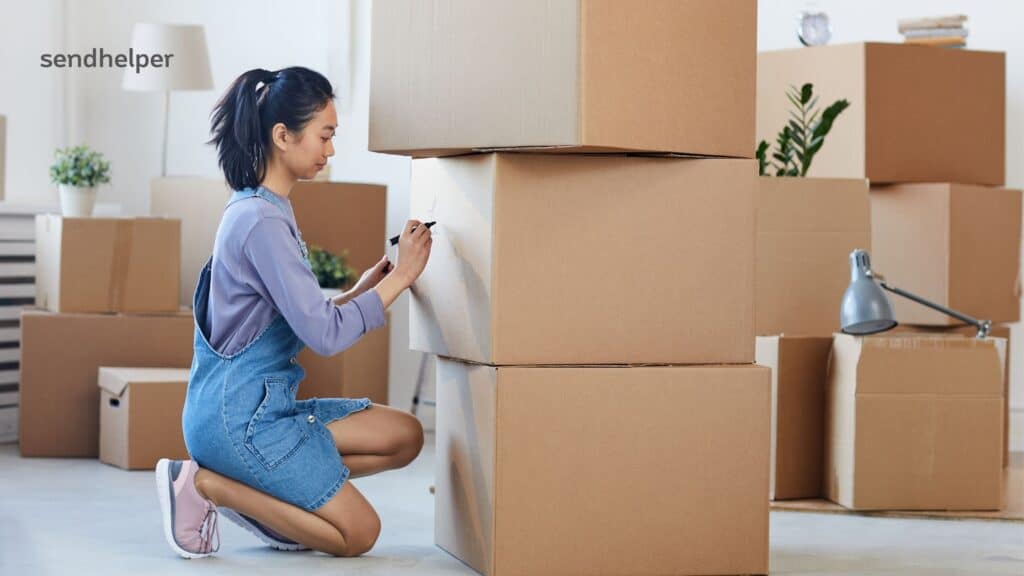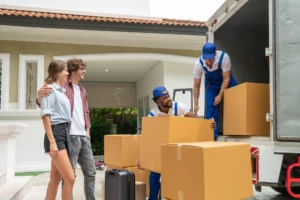Moving can be both an exciting and daunting experience. It’s a time of new beginnings and adventures, but the process of packing up all your belongings can be overwhelming. Fear not, for this ultimate guide to packing for moving in 2023 is here to help you navigate the entire process with ease and confidence.
Whether you’re moving to a new city or just across town, this guide will provide you with expert advice, practical tips, and a step-by-step packing checklist to ensure a smooth and successful move. So, let’s get started!

The Ultimate Guide to Packing for Moving in 2023
Having a detailed plan on how to pack for moving will help alleviate a lot of stress and confusion. To help you lessen the stress, here are some tips on how to get started:
Start Early and Plan Ahead
Packing for a move is a task that often takes longer than expected. To avoid last-minute stress, start the packing process as early as possible. Create a detailed plan outlining the packing timeline and prioritize rooms and items that are used less frequently.
Declutter and Downsize
Moving presents an excellent opportunity to declutter your belongings. Go through each room and decide what to keep, donate, sell, or discard. Reducing the number of items to pack will not only save time but also reduce moving costs.
Gather Packing Supplies
Ensure you have all the necessary packing supplies before you begin. This includes sturdy cardboard boxes, packing tape, bubble wrap, packing paper, markers, and furniture covers. Having the right materials on hand will make the packing process more efficient.
Create a Room-by-Room Packing Plan
To maintain organization, create a packing plan for each room. Pack similar items together and label each box with its contents and destination room. This will make unpacking a breeze once you arrive at your new home.
Pack Valuables Separately
Items of high sentimental or monetary value should be packed separately and carried with you during the move. These may include important documents, jewelry, electronics, and family heirlooms.
If you want to know how to pack antiques for moving, check out our guide here.
Wrap Fragile Items with Care
Fragile items require extra attention during packing. Wrap them individually with bubble wrap or packing paper, and fill any gaps in the box with cushioning material.
Utilize Proper Lifting Techniques
To prevent injuries, use proper lifting techniques when moving heavy items. Bend your knees, keep your back straight, and lift with your legs. If an item is too heavy, ask for help or use moving equipment like dollies or furniture sliders.
Pack Essentials in a “First-Night” Box
Pack a separate box with essential items you’ll need immediately upon arrival at your new home, including toiletries, a change of clothes, important documents, chargers, and any necessary medications.
Label Boxes Clearly
As you pack, label each box with its contents and the room it belongs to. This will save you time and frustration when unpacking, as you’ll know exactly where everything goes. LSI Keywords: Clear box labeling, Organized unpacking, Time-saving packing labels.
Disassemble Furniture with Care
If possible, disassemble furniture before the move. Keep all the screws and bolts in a labeled bag and tape it to the furniture for easy reassembly.
Use Clothing as Packing Material
Save on packing supplies by using your clothing as padding for fragile items. Wrap breakables in clothing items like sweaters or towels to provide extra protection.
Consider Professional Packing Services
If packing seems overwhelming, consider hiring professional packing services. They will efficiently pack your belongings, ensuring they are safe and secure for the move.
Pack Electronics with Care
For electronic devices, remove all cables and accessories and pack them separately. Use the original packaging if available, or wrap the devices in bubble wrap and place them in well-padded boxes.
Prepare Appliances for the Move
Before moving appliances, ensure they are properly cleaned and dried. If applicable, disconnect them from water and gas lines and secure any movable parts. If you want to know a detailed way how to pack appliances for moving, you can read it here.
Securely Seal Boxes
Use strong packing tape to seal boxes securely. Double-tape the bottom of the boxes for added reinforcement. This will prevent boxes from breaking open during the move.
Pack Books and Documents Properly
When packing books and important documents, lay them flat in small boxes to avoid damage. Do not overpack the boxes to keep them manageable in weight.
Pack an “Open Me First” Box
Pack a box containing items you’ll need immediately upon arrival, such as kitchen essentials, tools, and cleaning supplies. Mark this box as “Open Me First” to easily identify it among others.
Organize Cables and Wires
To avoid tangling, use zip ties or cable organizers to keep cords and cables together. Label each cable to know which device it belongs to.
Don’t Overpack Boxes
While it may be tempting to fill every inch of a box, avoid overpacking, especially with heavy items. Overfilled boxes may break or become too heavy to carry safely.
Pack Outdoor Items Separately
Items like garden tools, patio furniture, and outdoor sports equipment should be packed separately from indoor belongings. Clean and dry outdoor items before packing them.
Protect Mattresses and Furniture
Use mattress covers and furniture blankets to protect your mattresses and large furniture pieces during transit. This will prevent stains, tears, and other damages.
Safely Transport Plants
If you’re moving plants, make sure they are properly pruned and securely packed to prevent damage. Consider transporting them in your car to ensure they receive proper care.
Prepare Your Pets for the Move
Moving can be stressful for pets, so take extra care to prepare them for the journey. Keep them in a safe and familiar environment during the moving process.
Take Photos of Electronic Setups
Before disconnecting your electronics, take photos of the setup to help you remember where each cable goes during reassembly.
How To Pack a Desk For Moving
When you pack a desk, start by disassembling it and removing all drawers. Secure any movable parts with packing tape and wrap the desk in furniture pads or bubble wrap. Place heavy items near the bottom of the box for stability. When you finish, label the box with its contents and destination room.
How To Pack Vases For Moving
Packing vases to make sure they don’t break is a tricky process. Start by wrapping each vase in packing paper or bubble wrap, and place it inside an appropriately-sized box with extra cushioning material. Don’t forget to fill any gaps between the items with crushed paper or foam peanuts. Label the box with “Fragile” and its contents to prevent mishandling during transit.
How To Pack Hats For Moving
If you’re a hat collector and want to know how to pack hats for moving, start by filling a hat box with bubble wrap or packing paper. Place the hats in the box and fill any gaps with extra cushioning material. Seal it securely with packing tape and label it as “Fragile” to ensure careful handling during transit.
How To Pack Shoes For Moving
Our shoes are probably the most important items we pack when moving. To keep them safe, start by stuffing each shoe with packing paper or bubble wrap for extra protection. Place the shoes in boxes and fill any gaps with crushed paper or foam peanuts. Seal the box with tape and label it with its contents. This will help you unpack quickly and prevent damage to your shoes during transit.
How To Pack Knives For Moving
When packing knives, it’s important to protect yourself and others from potential harm. To ensure safety, start by wrapping each knife in packing paper or bubble wrap. Place them in a box and fill any gaps with extra cushioning material like foam peanuts. Seal the box securely with tape and label it as “Fragile” or “Sharp Objects” to prevent mishandling during transit.
How To Pack Mops And Brooms For Moving
Cleaning supplies like mops and brooms should be packed separately from other items. Start by taking the mop head off the handle and wrapping each item in packing paper or bubble wrap. Place them in an appropriately-sized box and fill any gaps with crushed paper or foam peanuts. Label them properly so it’s easier to unpack during the move.
How To Pack A Moving Container
Moving long distance can be overwhelming, but using a moving container can make the process easier. Start by packing your items in sturdy boxes and labeling them with their contents and destination room. Place heavier items near the bottom of the container for stability. Securely seal each box with tape and fill any gaps between boxes with bubble wrap or foam peanuts to keep them safe during transit.
How To Pack A Tupperware For Moving
Before packing your Tupperware, you must first make sure they are properly cleaned and dried. Wrap each piece in packing paper or bubble wrap for extra protection and place them in a box with other kitchen items. Fill any gaps between the items with foam peanuts and seal them securely with tape. Label the box as “Fragile” or “Kitchen Items” to prevent mishandling during transit.
How To Pack Purses For Moving
With all the stress of moving, it’s easy to forget the importance of packing your purses properly. Start by stuffing the bags with packing paper or bubble wrap for extra protection and placing them in a box along with other fashion items. Fill any gaps between items with crushed paper or foam peanuts and seal them securely with tape.
Hiring a Reputable Moving Company
Look for a professional moving company that is fully licensed and insured. Read online reviews and ask for references to ensure the movers you hire are trustworthy and reliable. Look for companies like Aleks Moving; our expert movers are ready and experienced to ensure your move is easy and stress-free.
Conclusion
Moving doesn’t have to be a stressful experience when you have the ultimate guide to packing for moving in 2023 at your disposal. By starting early, decluttering, and following expert packing tips, you can streamline the process and enjoy a smooth transition to your new home. Remember to prioritize organization, protect fragile items, and label boxes clearly for an easy and efficient unpacking process. Whether you’re moving locally or across the country, this comprehensive guide has covered everything you need to know for a successful move in 2023.
At Aleks Moving, we make sure that your move is as stress-free and easy as possible. Our experienced team of movers can handle all the packing and unpacking for you, so you don’t have to worry about a thing. We’ll provide you with the highest quality service at a competitive price. Contact us today to get started on your journey!
We hope this guide has been helpful in understanding the steps to take when packing for a move in 2023. With careful planning and expert help, you can ensure that your belongings arrive safely at their destination in a safe and familiar environment during the moving process. Good luck!
Thanks for reading! Best of luck with your move.
FAQs: The Ultimate Guide to Packing for Moving in 2023
How far in advance should I start packing for my move?
It’s best to start packing as early as 6-8 weeks before your moving date, especially if you have a large household and lots of items to pack. Starting early allows you to pace yourself and avoid last-minute stress.
Can I use regular cardboard boxes for moving?
While regular cardboard boxes may work for some items, it’s best to use sturdy moving boxes designed explicitly for this purpose. They offer better protection and durability during transit.
How can I prevent fragile items from breaking during the move?
Wrap fragile items individually with bubble wrap or packing paper and use cushioning material to fill gaps in the box. Clearly label the box as “Fragile” to ensure careful handling.
What should I pack in my “First-Night” box?
Pack essential items you’ll need immediately upon arrival at your new home, such as toiletries, a change of clothes, important documents, chargers, and any necessary medications.
Should I disassemble my furniture before moving?
Whenever possible, disassemble large furniture pieces to make them easier to transport. Keep all screws and bolts in a labeled bag and tape it to the furniture for easy reassembly.
Do I need to hire professional packers for my move?
Hiring professional packers can be beneficial, especially if you have limited time or need help with delicate items. They can efficiently pack your belongings and ensure their safety during the move.

